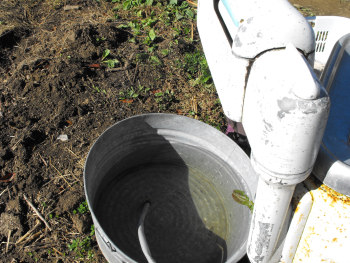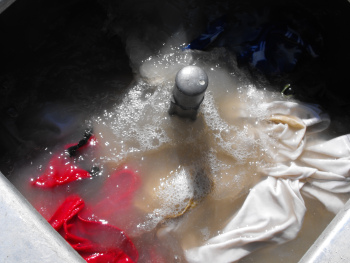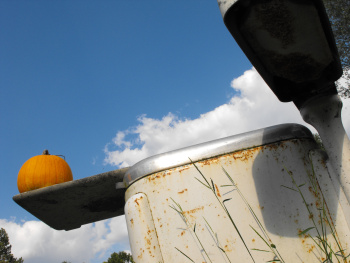
Wring Washer Tips
 To wash your clothes effectively in a wringer
washer you'll need the washer itself and a large washtub. You'll
need detergent too, of course --- liquid is easiest to use, but dry is
cheaper and quite feasible as well. In either case, be sure to
choose a phosphate free detergent since you're probably going to let
the waste water soak into the ground.
To wash your clothes effectively in a wringer
washer you'll need the washer itself and a large washtub. You'll
need detergent too, of course --- liquid is easiest to use, but dry is
cheaper and quite feasible as well. In either case, be sure to
choose a phosphate free detergent since you're probably going to let
the waste water soak into the ground.Now hook the drain hose in the upright position so that you can start to fill the wringer washer tub. Once it's got a few gallons of water in it, toss in your powdered soap and turn on the machine to dissolve the detergent while you're filling the tub the rest of the way up with water. (To turn on the agitator on my machine, I push in the big metal button on the front of the machine.) If using cold water in winter, you'll want to heat up a few gallons of water on the stove to dissolve your soap powder, or use liquid detergent.
While the wringer washer tub and the wash tub are filling with water, I sort my clothes. Most of you probably sort your clothes into white and colored, which is fine if you're a city person. Living on the farm, though, I sort my clothes into filthy (coated in mud) and just sweaty. The just sweaty clothes go in the washing machine first --- be sure not to overload the machine, then fill water the rest of the way up to the line. Turn on the agitator and let the washing machine run for half an hour.
 Once your half hour is up, turn off the
agitator and run your clothes one by one through the wringer, dropping
them into the washtub full of clean water for rinsing. There's a
switch on the side of the wringer which allows you to turn it off or
let it run clockwise or counter clockwise. You'll choose
clockwise or counter clockwise depending on the position of your
washtub --- it'll make sense once you play with it for a minute.
Once your half hour is up, turn off the
agitator and run your clothes one by one through the wringer, dropping
them into the washtub full of clean water for rinsing. There's a
switch on the side of the wringer which allows you to turn it off or
let it run clockwise or counter clockwise. You'll choose
clockwise or counter clockwise depending on the position of your
washtub --- it'll make sense once you play with it for a minute.The point of the wringer is to squeeze most of the soapy, dirty water out of the clothes. It can also grab onto your hand and do some damage, so be careful not to feed your fingers in with the clothes! On my wringer washer, I have to hold onto a handle at the top of the wringer with one hand to keep it squeezing while using the other hand to feed the clothes through. Jeans are sometimes too much for the wringer and will make it pop open --- a safety feature which prevents it from eating your hand. I often just set the jeans on the side of the washer to drip while I run the rest of the clothes through the wringer.
 Now put your filthy clothes into the dirty
water in the washing machine and turn the agitator back on. This
is a prewash to take out the filth. Meanwhile, swish the rinsing
clothes a little bit in the washtub, then run them through the wringer
again and into your laundry basket to be hung on the line. As you
finish putting your just-sweaty clothes through the wringer a second
time, stop the agitator in the washer and let down the drain hose so
that all the water drains out. Then hook the drain hose back up
and refill the washing machine with clean water and soap while you hang
your clean just-sweaty clothes on the line.
Now put your filthy clothes into the dirty
water in the washing machine and turn the agitator back on. This
is a prewash to take out the filth. Meanwhile, swish the rinsing
clothes a little bit in the washtub, then run them through the wringer
again and into your laundry basket to be hung on the line. As you
finish putting your just-sweaty clothes through the wringer a second
time, stop the agitator in the washer and let down the drain hose so
that all the water drains out. Then hook the drain hose back up
and refill the washing machine with clean water and soap while you hang
your clean just-sweaty clothes on the line.Repeat this process, agitating the pre-washed filthy clothes in soapy water for half an hour, then wring them into the rinse water (which may or may not need to be changed beforehand and refilled). Finally, wring them again into the laundry basket and hang them up. The whole process takes only a tad longer than using a conventional washing machine, saves water, and uses a very cheap piece of equipment which is nearly indestructible.

Anonymous --- I really love our wringer washer, but I'm not sure it'll solve all the problems you're hoping for. I crunched the numbers (and plugged in a kill-a-watt to our wringer washer) and I'm pretty sure that it uses nearly the exact amount of energy as a conventional washer on cold/cold. The real energy hog of clothes washing is heating the water, so if you want to cut back, that's where you should focus.
I also don't think the wringer washer makes things as clean as a conventional washer. I don't particularly care if a bit of grime creeps through --- I'm just washing farm clothes. But I think expecting cleaner clothes from a wringer washer than from a conventional washer might be a pipe dream.
On the other hand, a wringer washer really shines in the "turning a chore into fun" category! Who wants to be stuck in a laundry room when you can be outside listening to bird songs? Plus, if you have a very small house like we do, wringer washers can sit outside all winter since they don't keep water inside them when not in use. So they definitely have benefits, if not the ones you're envisioning.